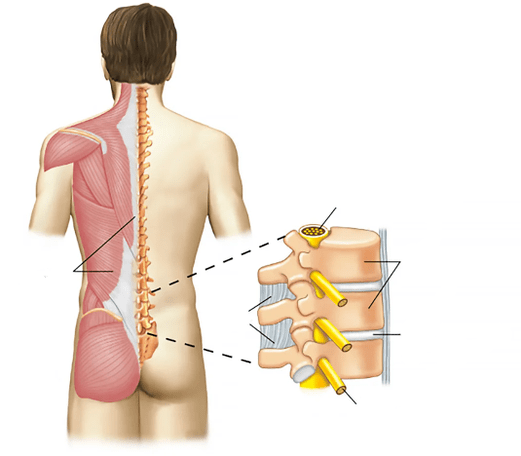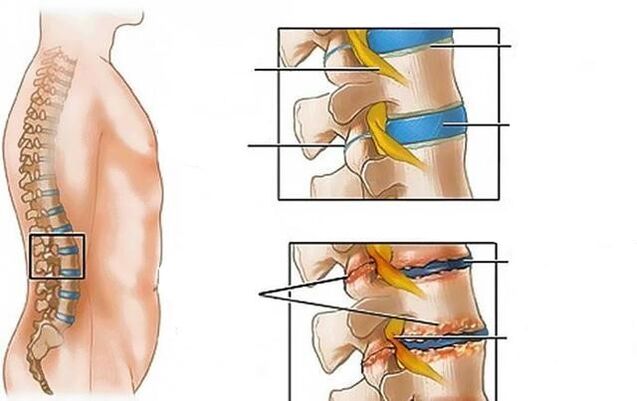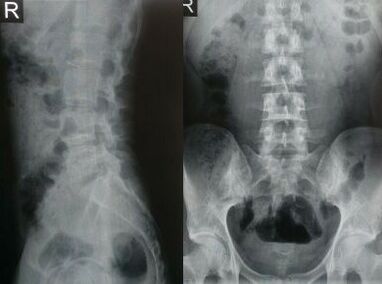Often pain in the lumbar spine indicates the development of pathology, including the appearance of an inflammatory process. If treatment is not started on time, symptoms will progress and it will be more difficult to restore health. In this article, you will learn about the causes and treatments for lower back pain.
If treatment is not started on time, symptoms will progress and it will be more difficult to restore health. In this article, you will learn about the causes and treatments for lower back pain.
Characteristics of back pain
According to the nature, pain is classified into 3 types:
Chronic.A person experiences discomfort during any physical activity - when bending over, climbing stairs or twisting their body. During the period of flare-ups (exacerbations), the pain can intensify and spread to different parts of the body.
Sharp.It occurs when the disc is moved and is characterized by sharp painful sensations in the lower back. Mobility is limited, a person cannot get out of bed, it is difficult for him to walk or bend over.
Painful.It is accompanied by unpleasant sensations that do not go away for a long time. As a rule, aching pain signals the development of diseases of the kidneys, genitourinary system. It can also be a symptom of osteochondrosis, spondylarthrosis, spondyloarthritis.

In addition to pain and discomfort in the lumbar spine, the patient may experience concomitant symptoms:
- muscular weakness;
- loss of control over urination and defecation;
- numbness in the legs;
- increased body temperature;
- chills;
- groin / crotch pain;
- violation of the menstrual cycle.
If the discomfort does not go away for a long time and a person complains of several symptoms at once, it is important to contact a therapist immediately. Only a doctor can make the correct diagnosis and prescribe treatment.
Causes of back pain
There are two main groups of diseases due to which pain syndrome develops in the lumbar region:
Spine problems:
Osteochondrosis.Degenerative-dystrophic disease in which the intervertebral discs lose their flexibility and ability to function normally. The disease can be resolved at the initial stage, subject to prompt treatment. Sharp pains, aggravated by flexion, indicate the gradual development of the disease.

Spondylosis.A disorder of the spine in which the intervertebral disc becomes severely exhausted and worn out. The cause of the pathology is trauma and increased stress on the spine. A person with spondylosis finds it difficult to turn their body. The disease is characterized by a slow course, so the result of treatment is often positive.
Scoliosis.Curvature of the spine, which can most often occur in adolescence due to rapid growth. The disease has 4 stages and can manifest as pain in the lower back.
Lumbago.Sudden shooting pain in the lumbar spine, in the event that a person freezes in an uncomfortable position. Mobility with lumbago is also limited.
Osteoporosis.A serious pathology in which the bony vertebrae become porous, lose their density and elasticity. Lower back pain can occur when lifting weights, changing body position, and other loads.
Systemic joint disease, wherein, a person experiences stiffness, pain and tension in the back muscles in the lumbar region. These unpleasant sensations can intensify at night and cause frequent awakenings. Pain is relieved with movement and exercise.

Myofascial syndrome.A fairly common disease that develops due to prolonged uncomfortable posture or after physical exertion. A distinctive feature is the presence of trigger points (pain) in the lower back or buttocks. When pressed, sharp pain occurs.
Diseases of internal organs:
Attack of appendicitis.Depending on the characteristics of the functioning of the human body, pain may appear on the right side and be transmitted to the lower back.
Inflammation of the kidneys.The main symptom in kidney failure is an unpleasant, pulling pain in the lumbar region. It can also be accompanied by the appearance of edema and an increase in body temperature.
PancreatitisWith the development of this disease, a person may experience nausea, vomiting, and upset stomach. If the pain in the lower back is caused precisely by pancreatitis, the pain does not increase when palpating the spine.
Cholecystitis.The pain is localized in the right hypochondrium, while it radiates to the lower back. Lumbago and discomfort in the lower back indicate the involvement of spinal nerve fibers in the pathological process.
EndometriosisA gynecological disease, in the event that the internal cells of the layer of the walls of the uterus grow beyond its limits. The woman experiences pain in the lumbar region.
Obesity.Being overweight puts unnecessary stress on the lower back and intervertebral discs. As a result, they deform and collapse. A person experiences discomfort when walking for a long time or climbing stairs.
Oncology.Low back pain can occur with a benign or malignant tumor. It "absorbs" a lot of calcium, there is a deficiency in the bone structures, they become thinner.
Physiological causes of back pain
Hypothermia. Prolonged exposure to fresh air in cold weather can cause numbness in the lower back. At the same time, discomfort increases when bending, moving and rotating. Sometimes it can give in the leg or buttock.
Critical days. During the menstrual cycle, about 50% of women experience unpleasant and tight sensations in the lower abdomen, which extend to the lumbar region. Typically, the discomfort goes away after the cycle ends.
Excessive load. Extreme weight lifting and too much stress on the lumbar region leads to painful sensations.
Climax. During menopause, the level of estrogen, a hormone that regulates recovery processes, decreases in a woman's body. Bone tissue loses its ability to fully recover. They become brittle.
Inconvenient shoes. Wearing high heels and tight shoes compresses the blood vessels in your legs. As a result, painful lower back pain occurs.
Lack of physical activity. A sedentary lifestyle and a lack of exercise contribute to chronic lower back pain. Muscles atrophy and lose their natural elasticity.
Diagnostic
First of all, the doctor questions and examines the patient. It prescribes the passage of a general chemical analysis (donation of blood and urine). To get a general picture and exclude serious pathological changes, it is recommended to go through:
CT.A modern diagnostic method with which you can detect the development of pathology at an early stage. He clearly visualizes all bone structures.
MRI.Shows the condition of soft tissue and cartilage. In addition, with the help of MRI, tumors, intervertebral hernias and changes in blood vessels are diagnosed.
X-ray.Provides information about changes in the bone structure of the spine, indicates the presence of bruises, microcracks and helps to detect pathologies of the spine.
Ultrasound.Allows you to determine the condition of internal organs, as well as to detect inflammatory processes.

Based on the data obtained, the doctor makes a diagnosis and prescribes treatment. If necessary, he offers to be examined by other specialists: gynecologist, endocrinologist, gastroenterologist.
How to treat low back pain
Methods of treatment depend on the disease and are prescribed individually. As a rule, complex therapy is the most effective. They generally recommend:
- avoid lifting heavy objects;
- take B vitamins and calcium;
- use a supportive bandage;
- swim, move more or take a medical gymnastics class;
- take corticosteroids to relieve severe inflammation (as directed by a doctor);
- muscle relaxants to relieve spasms.
Depending on the cause of the disease, the doctor may prescribe bed rest or, conversely, an increase in physical activity. For example, if the nerves are pinched, passive rest is recommended. For some muscle spasms, massage and moderate exercise. In addition, the treatment methods include:
Physiotherapy.Includes a number of methods of physical impact on the affected area. With its help, microcirculation improves, edemas and spasms disappear, and it is also possible to achieve an anti-inflammatory effect.
Manual therapy.A type of alternative medicine which is used to treat the musculoskeletal system. The specialist finds the place where the nerves are pinched and helps the spasmodic muscles to relax. It also invigorates places which, on the contrary, are very relaxed.
Acupuncture.Helps relieve pain through the use of special needles. They are injected into active points of the body and the spine. The muscles are relaxed and the lower back becomes healthier.
In case of failure of conservative treatment, it is necessary to consult a neurosurgeon. Most often, the operation is prescribed for intervertebral hernias, which have resulted in damage to the spinal root and the development of radicular pain.
What to do for severe lower back pain
For acute low back pain that cannot be tolerated, the patient is given a blockade. A procedure in which a doctor injects a pain reliever into an area where pain occurs or where a nerve fiber passes. This radical method temporarily relieves pain. In addition to this, a specialist can prescribe antibiotics, immunomodulators and chondroprotectors.
In case of severe back pain, do not treat yourself and do not endure. This can lead to fatal consequences, including disability or death.
Prevention and prognosis
Try to keep a balance between work and play. A sedentary lifestyle and lack of physical activity are the main causes of back pain.
If you work at the computer or drive all day, try to find time to exercise or go for a walk. It is not necessary to spend two hours in the lobby. You can choose a doable exercise from yoga, fitness, or Pilates and do it at home.
Carry weights in your backpack. This will help to evenly distribute the load on your back and not tear it off. When lifting something heavy, bend your legs, not your back. If you have to reach from the top, use a ladder or a chair.
Get a massage. Visit a massage therapist twice a year and take a massage course of at least 10 sessions. This will help relieve muscle spasms and promote overall health.
Obtain an orthopedic mattress and pillow. In a dream, a person spends ⅓ of his life. Make sure that during this time you feel comfortable and can completely relax. Buy products at an orthopedic salon after consulting with a salesperson.
In order not to injure yourself, be careful with the methods of folk medicine and self-medication. If you need help from a specialist, you can contact our clinic. To make an appointment, leave a request or call.























